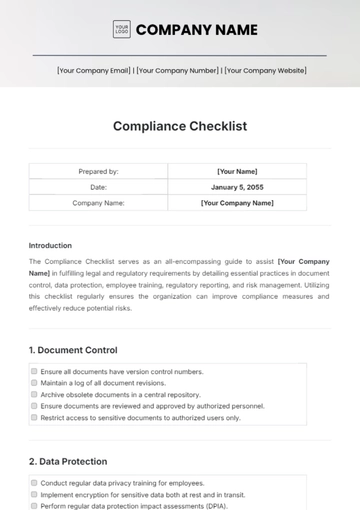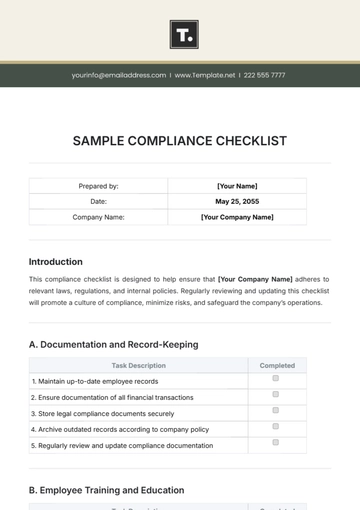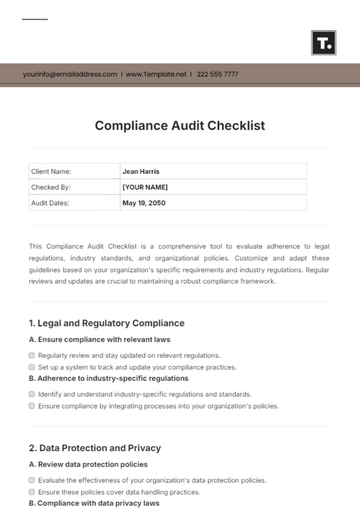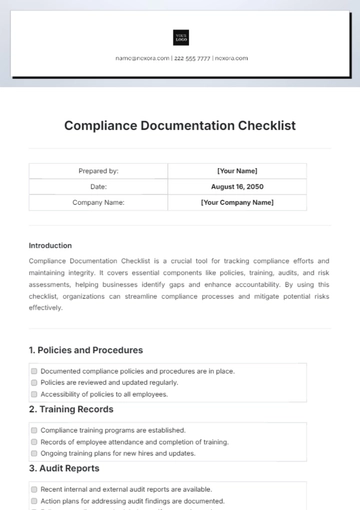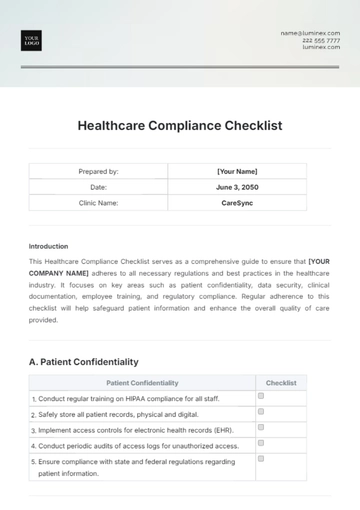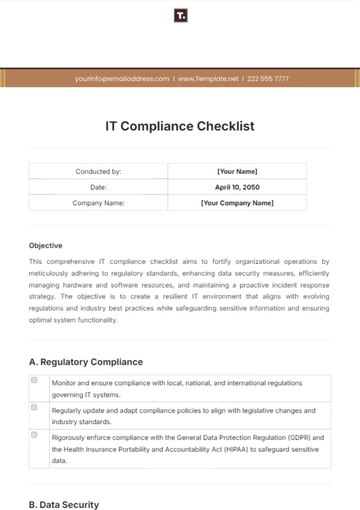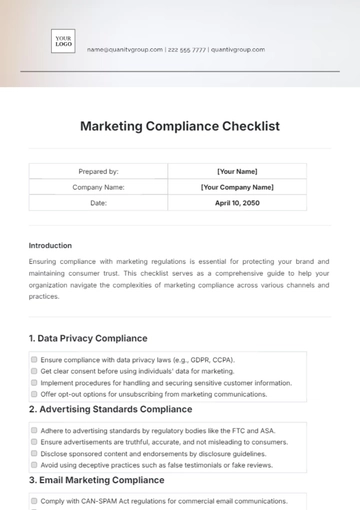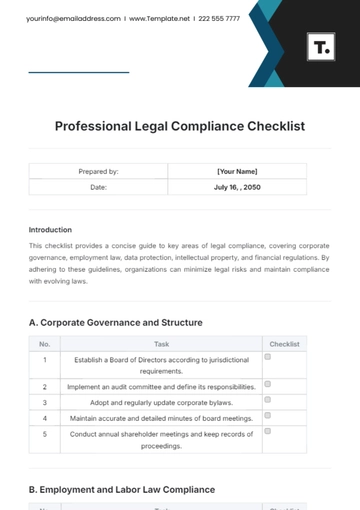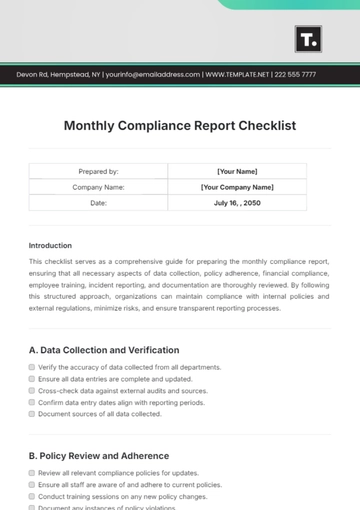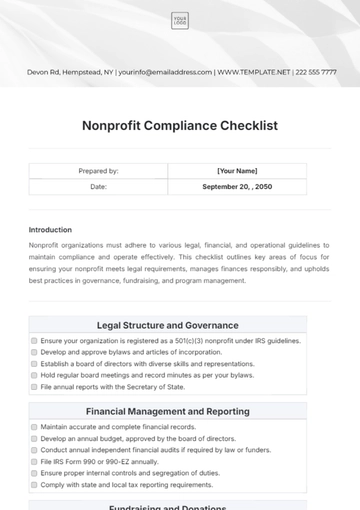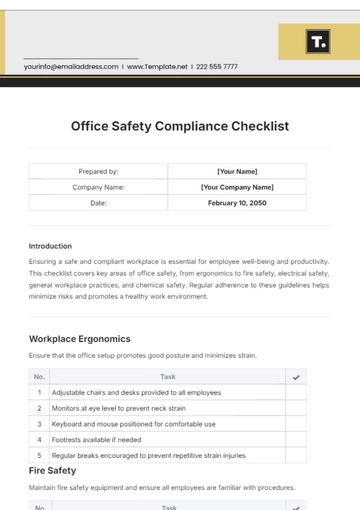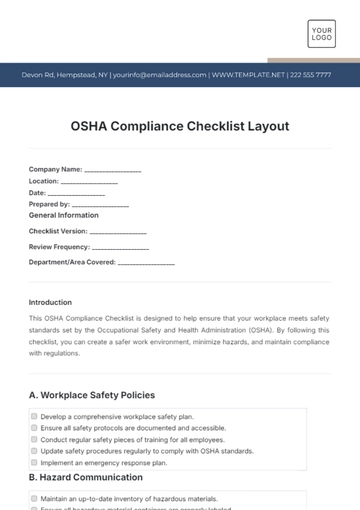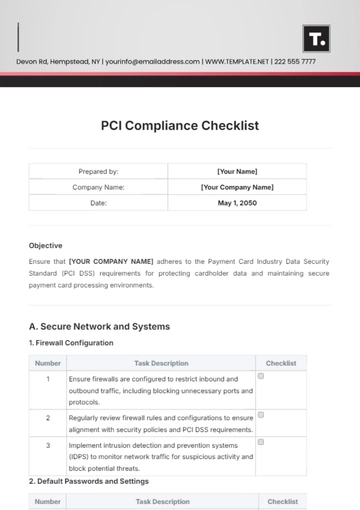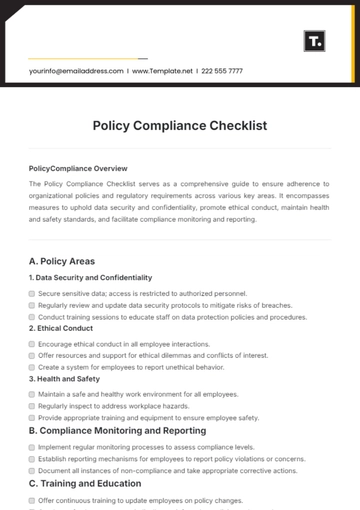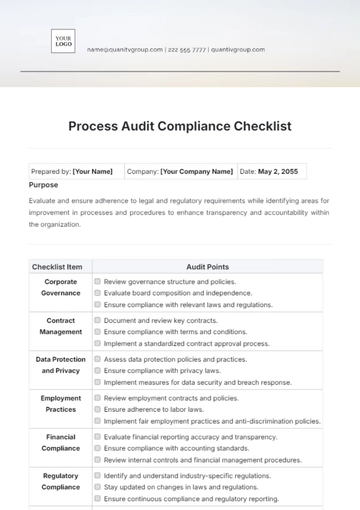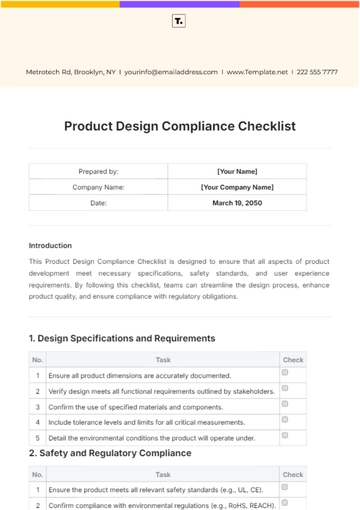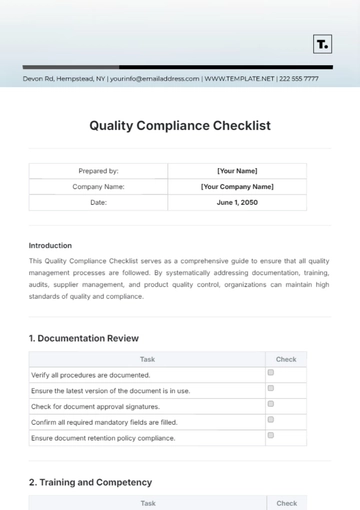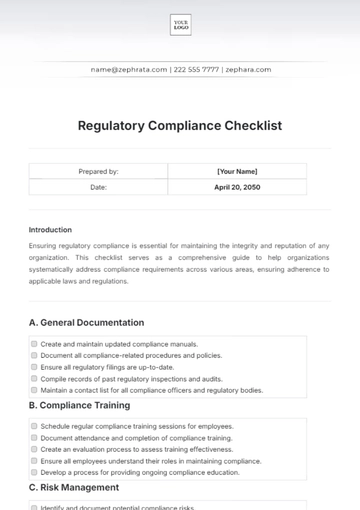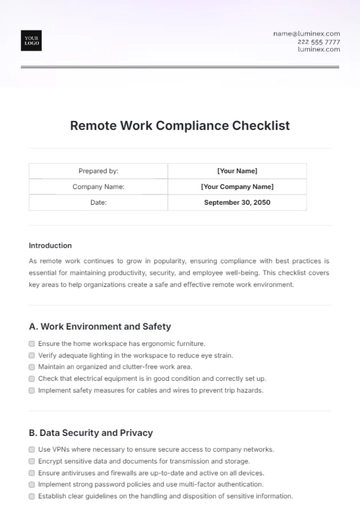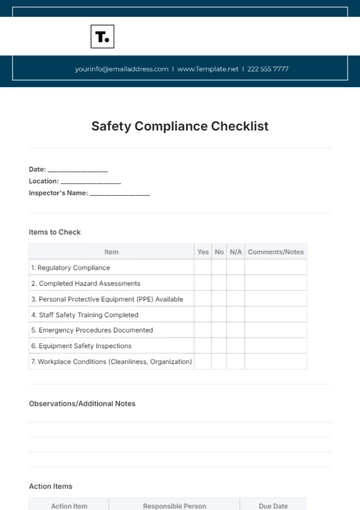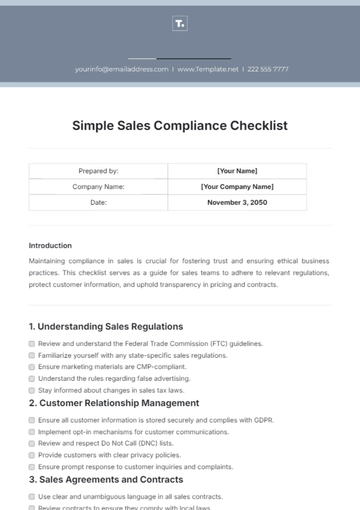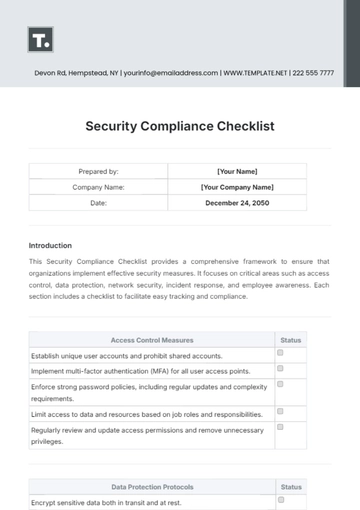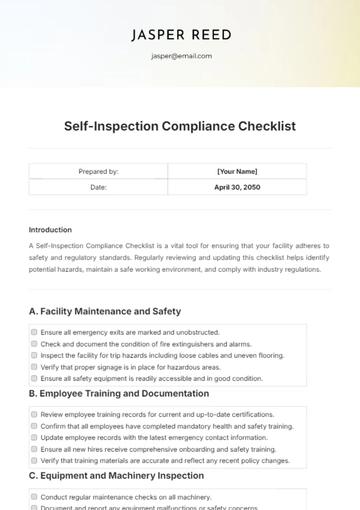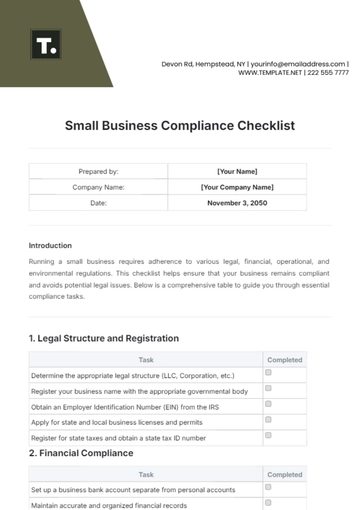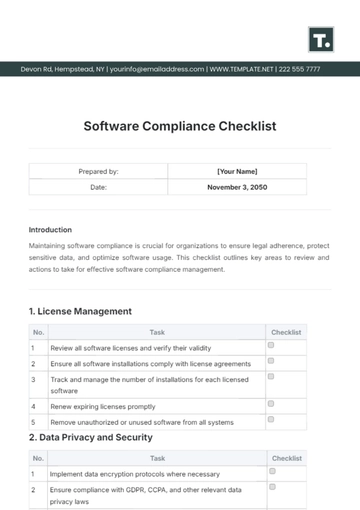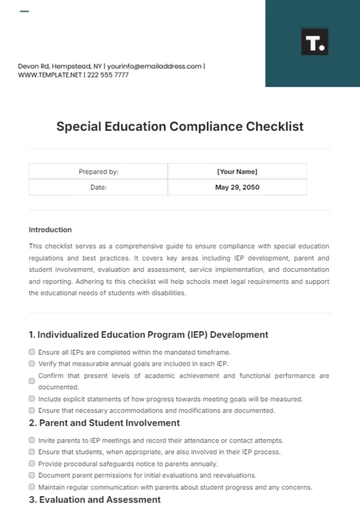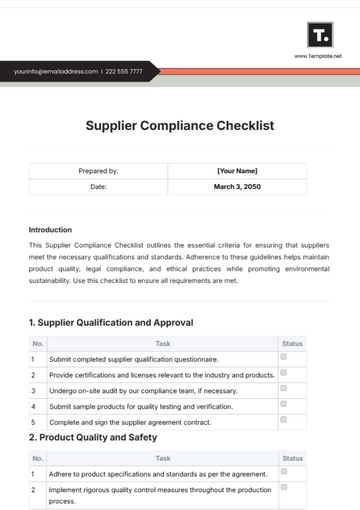Free Environmental Compliance Checklist

I. Compliance Overview
Objective: Ensure that [YOUR COMPANY NAME] adheres to environmental regulations and practices to minimize environmental impact and promote sustainability in business operations.
Responsible Party: [YOUR NAME], Environmental Compliance Officer
Date of Last Review: [DATE]
Next Scheduled Review: [NEXT REVIEW DATE]
II. Regulatory Compliance
1. Environmental Permits:
Obtain and maintain air, water, and waste permits.
Ensure compliance with business operations.
Adhere to regulatory requirements.
2. Regulatory Reporting:
Submit emissions reports to regulatory authorities.
File discharge monitoring reports accurately and promptly.
Provide hazardous waste manifests as required.
3. Compliance Monitoring:
Conduct regular inspections for environmental compliance.
Monitor pollutant emissions and wastewater discharges.
Ensure proper waste management practices are followed.
III. Pollution Prevention
1. Air Quality Management:
Install emissions control equipment.
Optimize combustion processes for reduced emissions.
Promote energy efficiency to mitigate air pollutants.
2. Water Conservation:
Implement measures to reduce water usage.
Minimize wastewater generation.
Protect water resources through conservation efforts.
3. Hazardous Materials Management:
Store hazardous materials properly.
Handle hazardous materials with care.
Dispose of hazardous wastes in compliance with regulations to prevent pollution and environmental risks.
IV. Waste Management
1. Waste Reduction:
Initiate waste reduction initiatives.
Implement recycling programs.
Utilize source reduction measures.
Promote product stewardship efforts.
2. Recycling and Reuse:
Establish recycling programs.
Implement reuse initiatives.
Include materials like paper, plastics, metals, and electronics.
Divert waste from landfills and conserve resources.
3. Hazardous Waste Handling:
Properly label hazardous wastes.
Store hazardous materials safely.
Dispose of hazardous wastes in compliance with regulations.
V. Environmental Management Systems (EMS)
1. EMS Development:
Develop an Environmental Management System (EMS).
Systematically manage environmental aspects and impacts.
Ensure compliance with regulations.
Establish environmental objectives.
2. Continuous Improvement:
Monitor EMS effectiveness through audits.
Conduct management reviews.
Evaluate performance regularly.
Implement corrective actions for improvement.
VI. Energy Efficiency
1. Energy Conservation:
Implement energy conservation measures.
Reduce energy consumption.
Increase energy efficiency.
Lower greenhouse gas emissions.
2. Renewable Energy:
Explore renewable energy sources.
Consider solar, wind, or geothermal energy.
Reduce reliance on fossil fuels.
Support sustainable energy practices.
VII. Community Engagement
1. Stakeholder Communication:
Engage with employees, communities, and regulatory agencies.
Communicate environmental goals and initiatives.
Solicit feedback and input from stakeholders.
2. Environmental Education:
Provide environmental education programs.
Raise awareness about environmental issues.
Promote sustainability practices.
Encourage participation in environmental initiatives.
VIII. Signature
By signing below, you acknowledge that you have reviewed and understand the contents of this environmental compliance checklist and affirm [YOUR COMPANY NAME]'s commitment to environmental stewardship and sustainability.

Environmental Compliance Officer
[YOUR COMPANY NAME]
Date: [DATE]
- 100% Customizable, free editor
- Access 1 Million+ Templates, photo’s & graphics
- Download or share as a template
- Click and replace photos, graphics, text, backgrounds
- Resize, crop, AI write & more
- Access advanced editor
Ensure environmental compliance effortlessly with Template.net's Environmental Compliance Checklist Template. This meticulously crafted resource is fully editable and customizable, allowing you to tailor it to your specific needs. Utilize our Ai Editor Tool to easily modify and adapt the checklist to meet your unique requirements. Simplify compliance procedures today.
You may also like
- Cleaning Checklist
- Daily Checklist
- Travel Checklist
- Self Care Checklist
- Risk Assessment Checklist
- Onboarding Checklist
- Quality Checklist
- Compliance Checklist
- Audit Checklist
- Registry Checklist
- HR Checklist
- Restaurant Checklist
- Checklist Layout
- Creative Checklist
- Sales Checklist
- Construction Checklist
- Task Checklist
- Professional Checklist
- Hotel Checklist
- Employee Checklist
- Moving Checklist
- Marketing Checklist
- Accounting Checklist
- Camping Checklist
- Packing Checklist
- Real Estate Checklist
- Cleaning Checklist Service
- New Employee Checklist
- Food Checklist
- Home Inspection Checklist
- Advertising Checklist
- Event Checklist
- SEO Checklist
- Assessment Checklist
- Inspection Checklist
- Baby Registry Checklist
- Induction Checklist
- Employee Training Checklist
- Medical Checklist
- Safety Checklist
- Site Checklist
- Job Checklist
- Service Checklist
- Nanny Checklist
- Building Checklist
- Work Checklist
- Office Checklist
- Training Checklist
- Website Checklist
- IT and Software Checklist
- Performance Checklist
- Project Checklist
- Startup Checklist
- Education Checklist
- Home Checklist
- School Checklist
- Maintenance Checklist
- Planning Checklist
- Manager Checklist
- Wedding Checklist
- Vehicle Checklist
- Travel Agency Checklist
- Vehicle Inspection Checklist
- Interior Design Checklist
- Backpacking Checklist
- Business Checklist
- Legal Checklist
- Nursing Home Checklist
- Weekly Checklist
- Recruitment Checklist
- Salon Checklist
- Baby Checklist
- Equipment Checklist
- Trade Show Checklist
- Party Checklist
- Hospital Bag Checklist
- Evaluation Checklist
- Agency Checklist
- First Apartment Checklist
- Hiring Checklist
- Opening Checklist
- Small Business Checklist
- Rental Checklist
- College Dorm Checklist
- New Puppy Checklist
- University Checklist
- Building Maintenance Checklist
- Work From Home Checklist
- Student Checklist
- Application Checklist
